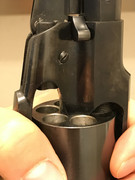Crypt0manic
40 Cal
- Joined
- Jul 30, 2021
- Messages
- 178
- Reaction score
- 45
What it is is that the flat surface (has to be large enough to do it) creates a pocket in front of the bullet that pushes the liquid, which can’t be condensed, out of the way, which is what causes the wound to become larger than the caliber, even at low velocity. The same technology was introduced by the Russians with torpedoes. They found that the pocket or bubble ahead of the torpedo allowed it to sail through the water without as much resistance. I don’t know the specifics but it’s hydraulic. So it does sort of work like a HP but with less devastation but keeping its penetration capabilities.
Hmmm, seems like you have a little more meat between your chambers than I do. Are the chambers chamfered?
I use a slightly undersized dowel rod to form my paper cartridges.
I use rolling papers too, and get the little shards of paper left occasionally in chambers. I was picking them out but then decided to see if they’d cause an issue. I only had enough to run 3 cylinders full, but it didn’t cause any ignition problems.
You can nitrate the paper. I tried it but it was messy so I gave up on it. They work fine and it’s not like I’ll need a dozen reloads going into battle somewhere.
Ooh thanks man! Do you btw use any wax or anything in front of the bullet to prevent chainfire while using the cartridges? I guess you do but would like to check if there are any tricks for that part. I mean since it's slowing down the loading process alot.
I realized lately while i was outside shooting that the wind makes it hard to measure powder and all that with the stuff i got. So guess i might make more cartridges for windy days.
I might try to fire all of the 6 cartridges i made in the same chamber i guess as a type of test to see how many it takes before it starts to misfire etc...i just used a simple pen for making them didn't find anything more
Not sure what you mean by chamfered chambers really. i can send a couple pictures here of the cylinder etc not sure if it helps tho. Is there a way to see difference between a original one and replicas? I mean could the chamber be from some replica?
That would be weird because of our laws but would be good since the replicas might have better steel. I would worry less about the chamber explosions haha
The text on the backside of the cylinder is only the letter P. Not sure what that stands for.
Attachments
Last edited:








